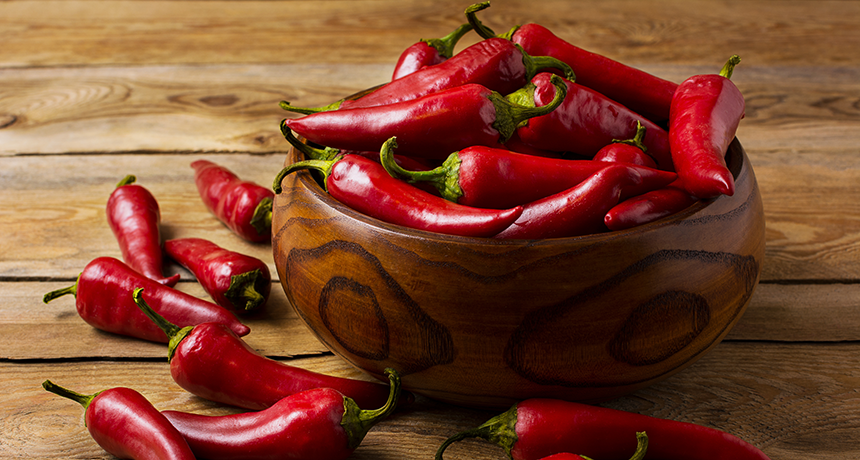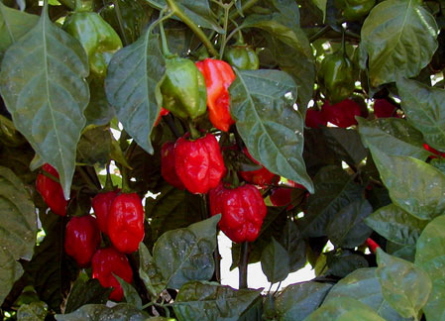A pepper part that burns fat
Study finds that dihydrocapsiate may give a diet extra power.

Capsaicin is what makes chili peppers so hot. A chemical cousin of capsaicin, also in peppers, will not burn the tongue. The good news for dieters: It does burn fat.
TasiPas/iStockphoto
By Stephen Ornes
Diet fads come and go, but in the end, there’s really only one rule for losing weight: Burn more energy than you consume. In April, scientists from California reported on a chemical that might help people burn fat. It comes from a pepper. And in a recent study it was shown to boost how much energy the body burns.
Its name, dihydrocapsiate (Dy-HY-droh-CAP-see-ate), isn’t easy to say. And Peter Piper never picked it. But it might be easy to find: It is a chemical cousin of capsaicin (Kap-SAY-sin). That’s the chemical that makes chili peppers so hot. But unlike its fiery kin, dihydrocapsiate won’t send diners running for a glass of water. In fact, you won’t even know it’s in your body.
Painful foods — like the ones that contain capsaicin — stimulate pain receptors in the mouth. These pain receptors go on to signal nerves, which send a message to the brain. Dihydrocapsiate, however, is too big to fit into the receptors and tickle those nerve endings. That means it enters and passes through the body without causing pain.
 |
|
The main compound that gives peppers (pictured are red savina habaneros of New Mexico) their sting has a close cousin that may burn body fat without irritating the mouth or stomach.
|
| NSF; Chile Pepper Institute |
David Heber is a scientist at the University of California, Los Angeles. He reported on the dihydrocapsiate research in April during a meeting of scientists who study nutrition. His team tested the chemical on 33 obese men and women. For four weeks, these people consumed only 800 calories per day, and all of those calories came from a nutritious liquid (not solid foods). These liquids contained no fat.
At every meal, the participants also were given pills. People in one group received pills that didn’t do anything. Such “treatments” are called placebos. They are compared to the impacts of a real drug. Doing so helps experimenters figure out whether a test drug really works. In this study, some participants were given a small dose of dihydrocapsiate. Others got a high dose of dihydrocapsiate.
All of the pills looked the same. In this way, none of the participants nor the doctors knew who had consumed placebos and who had consumed the pepper chemical.
After the end of the diet trial, the scientists determined how much fat the participants had been burning.
And not everyone had burned the same amount. People given high doses of dihydrocapsiate were burning more body fat than were people who had been given placebos, UCLA’s Heber says. They burned so much more, he says, that the people taking high doses of dihydrocapsiate may have been losing one pound more per month than the people taking placebos. But that’s a guess: The scientists didn’t measure that number, so they don’t know for sure.
Heber and his team think that the pepper chemical works by attaching itself to another type of receptor, this one in a person’s gut. This receptor helps send a message to the brain. It then starts a process that causes a body to burn, burn, burn calories. This process is the same one that, when triggered by capsaicin, causes some people to sweat while they eat hot foods. The scientists say that capsaicin could have the same effect as the dihydrocapsiate. The big difference: Capsaicin causes intense pain to a person’s mouth and gut.
Dihydrocapsiate could help people lose weight, delivering the positive effects of hot peppers without the fiery side effects. In theory, the chemical could be consumed safely and help a 100-pound person burn an extra 160 calories per day.
Of course, it would be very easy to undo these sizzling effects with one slice of cake or a sugary soft drink. A chemical like dihydrocapsiate may help a person burn more than he consumes — but it can’t change a person’s eating habits.
“As I always say,” Heber told Science News, “a supplement doesn’t make up for diet.”
This story and other Science News for Kids features describing research in medicine and biology are supported with funding from The Lasker Foundation. The foundation and its programs are dedicated to the support of biomedical research toward conquering disease, improving human health and extending life.
Going Deeper:
Raloff, Janet. 2010. “Chili pepper holds hot prospects for painfree dieting,” Science News, April 27. Available at http://www.sciencenews.org/view/generic/id/58689/title/Science_%2B_the_Public__Chili_pepper_holds_hot_prospects_for_painfree_dieting
Picked a pepper? Find out how hot it is using the Scoville scale: http://www.chilliworld.com/FactFile/Scoville_Scale.asp
Sohn, Emily. 2006. “Hot pepper, hot spider,” Science News for Kids, November 15. http://sciencenewsforkids.org/articles/20061115/Note2.asp
Sohn, Emily. 2009. “Greener diet,” Science News for Kids, February 25. http://sciencenewsforkids.org/articles/20090225/Note2.asp







